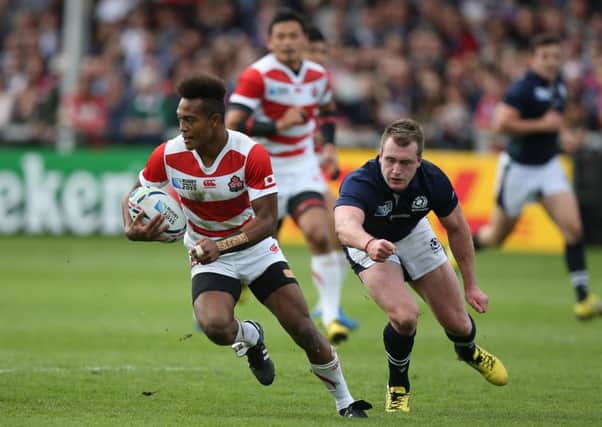Japan give hope to skill over strength rugby


Up until Japan unleashed one of the biggest upsets in sporting history against South Africa, the received wisdom was that you needed power, size and more power to compete at the highest level in rugby. So it has been that backs, in the absence of Shane Williams and Gloucester’s favourite son James Simpson-Daniel, have grown to almost the same size as forwards.
Sonny Bill Williams would have played No 8 in the amateur era where his shoulder would have been up against Sam Burgess’ backside because the English centre would have been shooed straight into the second row. We have all of us been participating, some more willing than others, in the biggest arms race in sporting history. Big is beautiful with a small and falling number of exceptions proving the rule.
Advertisement
Hide AdAdvertisement
Hide AdThings are getting out of hand. French prop Uini Atonio is 23st (145kgs) and 6ft 6in. One website cheekily worked out that he wears an XXXXXXXXXL shirt. I’d like to see him cope with the Brave Blossoms in full flight.
Toulon have bossed the European club scene like a school bully with three trophies in as many years thanks to the largesse of Mourad Bourgellal because they buy the biggest players on the planet. It is the received wisdom and it works for them. Japan have shown us that the received wisdom isn’t the only wisdom in the playground.
Eddie Jones’ team played the game at such a pace that the giants in international rugby couldn’t live with it. South Africa lost to them and, while Scotland did not, still Vern Cotter’s side spent 30 deeply uncomfortable minutes in the middle of Wednesday’s match reeling on the ropes not knowing where the next blow was coming from. The ferociously fit Japanese forwards act like a swarm of bees, hunting as a pack and targeting any opponent who gets isolated. In attack, the Blossoms play flat with a phalanx of receivers in the midfield, any one of whom could get the ball. They constantly shift the point and they vary the angle of attack and they do both the above at a tempo that is difficult to follow from the touchlines never mind defend against on the field of play.
Some things cannot be painted over and power is still required, even by quick-witted, quick-thinking teams like Japan. It was no coincidence that they floundered only when their wrecking ball of a No 8, the Tongan Naki Mafi, was injured. But, while Japan had some muscle, most of their players could pass for normal members of the human race if you bumped into them on the high street. I chatted to the lock Luke Thompson in the pre-match press conference. I am 6ft 1in. He is bigger than me but not much. Grant Gilchrist and the Gray brothers are built to a completely different blueprint. Rugby is no longer a game for all shapes and sizes but, after watching Japan at work, you wonder why not.
Eddie Jones’ team are showcasing a different way to play the game. Simply put, they use pace to impose themselves on the opposition rather than power. If you are being picky, Japan utilise both, but it is pace that gives them an edge. It is akin to Barcelona’s footballing philosophy where lots of small but highly skilled individuals play their part in a well-oiled machine.
Glasgow are a halfway house and they did something similar but subtly different in the Pro 12 final, whether by choice or necessity is not obvious. With Munster the masters at slowing opposition ball at the breakdown, Glasgow did away with them, as far as is possible, with an endless series of little offloads and passes out of the tackle that occasionally resembled bad sevens. The tactic effectively prevented Munster from even competing for the ball at the (non-existent) breakdown never mind winning it. Japan do take the tackle but they recycle so quickly that it is impossible for teams to maintain any sort of line speed against them.
Will Japan’s dynamic displays at this World Cup persuade the game’s intelligentsia to concentrate on skill and speed rather than brute force or will Japan’s excellence be forgotten while everyone else in the sport returns to the arms race? In short, is it easier to up-skill a player on the training field or bulk him up in the gym?
I don’t know the answer, but I know that smart people, and the game is full of them with each and every one looking for that little edge, will be scratching their heads and wondering quietly to themselves if Jones’ Japan might have hit upon something?